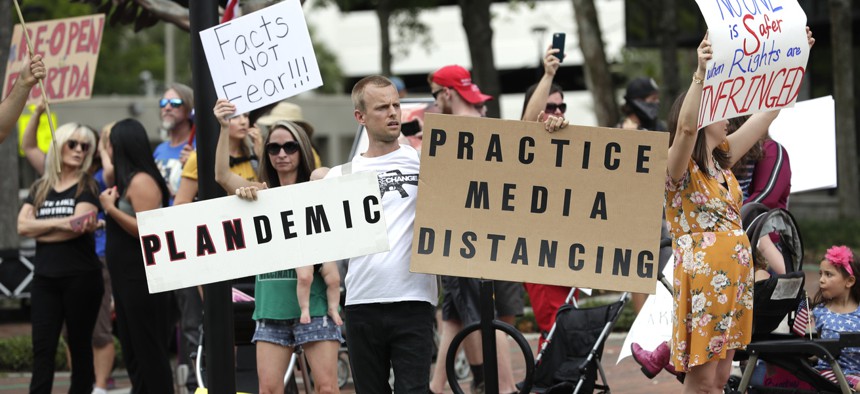Conspiracy Theories Abound About the Coronavirus. How Officials Can Deal with Them.

Protesters in Florida showed a deep suspicion of efforts to shut down daily life to slow the spread of the coronavirus. AP Photo/John Raoux
During the protracted coronavirus crisis, conspiracy theories can develop staying power. Experts say clear communication is crucial to dispelling disinformation and combatting conspiracies.
It’s not uncommon for conspiracy theories and disinformation to emerge during crises. In the wake of mass school shootings that grow into national tragedies, like Sandy Hook and Parkland, rumors often spread that the events never happened and the people interviewed on the news are paid crisis actors. Many natural disasters spur conspiracy theories, as well, like those that popped up in the wake of the California wildfires last year.
But the conspiracy theories and disinformation campaigns during the coronavirus pandemic are different than those that emerge in other emergency situations. Most crises have short impact periods—an earthquake might knock down cell towers, for example, and theories spread as to why, but once the towers are back, the conspiracies dissipate. That’s not what’s happening now, explained Kate Starbird, a professor at the University of Washington who co-founded the Center for an Informed Public, which researches the spread of false information. “In most crises, the uncertainty resolves pretty quickly,” she said. “With something like Covid, there’s persisting scientific uncertainty about things like how the virus spreads, what immunity looks like, and how long people are contagious. In the absence of solid answers, people are getting anxious and going online to find explanations.”
The type of erroneous information people find varies. There’s misinformation, which is false or misleading information often spread unintentionally; disinformation, which is intentionally false information spread with an underlying motive, usually political or financial; and conspiracy theories, which happen when people take an existing set of beliefs (like that the mainstream media is lying to them) and apply it to the current situation. Starbird said these types of false information often blend together during times of great anxiety when we take part in what she called “a collective sense-making process” that “stirs the rumor mill.” She said to think of conspiracies and disinformation less like pieces of information and more like campaigns that take root and change over time.
.jpg)
Social media has provided fertile ground for conspiracies about coronavirus, from the banal—like the recommendation to microwave mail to kill the virus—to the bizarre—like the theory that the virus response in New York is an elaborate coverup to rescue “mole children” from underground tunnels by bringing them up through medical tents in Central Park. Some of them, though, are downright dangerous, leading public officials struggling to convince people of the truth.
On the international stage, the World Health Organization has a page dedicated to busting myths about coronavirus, most of them related to false cures or preventative measures that don’t actually work or could be harmful. Officials in the U.S. are now urging caution over the use of hydroxychloroquine, which President Trump repeatedly touted as a possible wonder drug, after one study found that it was actually associated with an increased risk of death from Covid-19.
In New York, where both the state and local governments are the subject of several conspiracy theories, officials say they are doing all they can to combat disinformation. Freddi Goldstein, the press secretary for New York City Mayor Bill de Blasio, said that keeping the public informed is “critical to the safety of all” during the pandemic. “During a time of crisis, it’s crucial people have access to accurate and reliable information,” Goldstein said. “That’s why the mayor holds a daily press conference and we push information out on social media throughout the day.”
A representative of the New York City Emergency Management Department said that the city has a “robust plan” for circulating timely information, including a website, daily press briefings, social media posts, and an emergency text alert system that provides information to the 850,000 residents who have signed up. All these communication methods are used to “quickly and aggressively dispel any rumors or disinformation during this response,” the representative said.
On Sunday, New York Gov. Andrew Cuomo sought to dispel rumors that officials are exaggerating Covid-19 numbers. “Some people say coronavirus is a hoax,” he said. “Six hundred people died two days ago … 16,000 people in hospitals test positive for coronavirus. That is a fact. I don’t care what you think or what your opinion is … you can’t say it’s a hoax.”
“Facts are facts,” he concluded.
But the complication with coronavirus, which emerged in China just late last year, is that the facts keep changing as our understanding of the virus evolves, said Starbird. At the beginning of the pandemic, organic misinformation spread as people looked for ways to protect themselves. Now, “science has become politicized,” she said.
.jpg)
A prime example of that are last week’s protests on several state capitols against governors’ stay-at-home orders, agitating for reopening the local economy. Protest attendees were quoted in the media saying they believed coronavirus was a hoax to hurt the president and, therefore, didn’t see the need to wear masks or practice social distancing. That’s where disinformation presents a clear danger, Starbird said. The protests have experts worried about the rise of “astroturfing” during the pandemic, the term used when well-funded people or organizations covertly initiate political activity that is intended to look like a spontaneous, grassroots movement. With the statehouse protests, the Washington Post and New York Times have both reported that influential conservative groups supported and helped foster the events.
Starbird said one concern about the growing distrust of official proclamations about Covid-19 seen at these protests is that it could lay the groundwork for future campaigns, such as those against getting vaccinated once a shot is developed.
The shifting landscape of information about coronavirus has led to a “choose your own adventure scenario” where people decide which information to believe, said Joseph Uscinski, a political scientist at the University of Miami who specializes in conspiracy theories. “The people who tend to believe in the coronavirus conspiracies also believe them about other things, like AIDS and Zika and swine flu,” he said.
In March, Uscinski conducted a survey of 2,000 people, asking whether they believe the virus is being exaggerated to hurt Trump and whether they believe it was intentionally created and spread. About a third of respondents said yes to each question, which is higher than usual belief numbers for medical conspiracy theories. But Uscinski said there is good news hidden in those numbers—because they could be much higher. “If we tried to create the perfect laboratory conditions to get people to believe a conspiracy theory, we couldn’t think of something better than reality right now,” he said. People are largely stuck at home, where they can be overwhelmed by anxiety, boredom, and feelings of loss of power, as well as grow concerned about the increased government control of daily life and a devastating economic downturn.
“You would expect 100% of people to believe theories, but we don’t find that,” Uscinski said. “Given that everyone is singularly focused on this one issue, you’d think there would be more.”
But those numbers are still high, and public officials have to deal with the consequences. Both Starbird and Uscinski offered state and local leaders the same advice: ignore the craziest of the crazy. Don’t give official responses to “mole children” theories or expend much energy on people who are deeply anchored in conspiratorial beliefs. “You’ll go crazy trying to convince that very last one percent,” Uscinski said. Starbird instead suggested focusing on people who are struggling in the information space and might be “peeking at the rabbit hole, but haven’t drifted down.”
For that subset of the population, Uscinski said officials should be using “clear, crisp messaging” delivered by trusted voices in different communities. Starbird warned that leaders should be careful not to oversimplify messages. “You have to tell people things are a little uncertain, because if you don’t and things change, you lose trust,” she said. “As information consumers, we also have to take responsibility here. We can’t expect to be talked to like children. We have to be a little comfortable with uncertainty.”
Emma Coleman is the assistant editor for Route Fifty.
NEXT STORY: In a Hawaii Sewage Case, Supreme Court Bolsters Protections Under Clean Water Act






